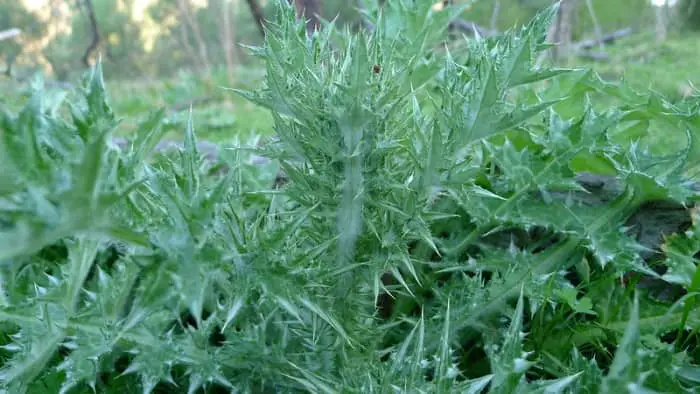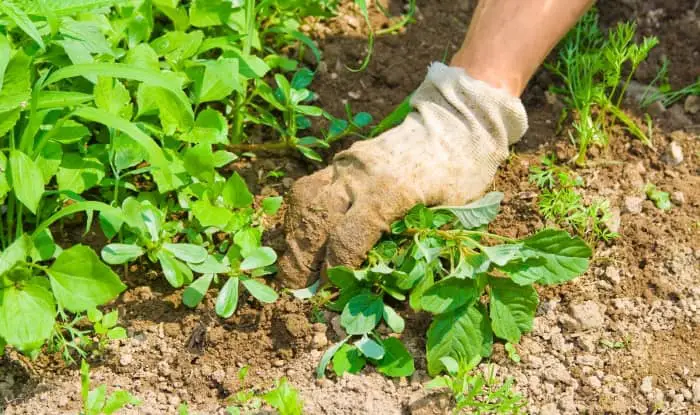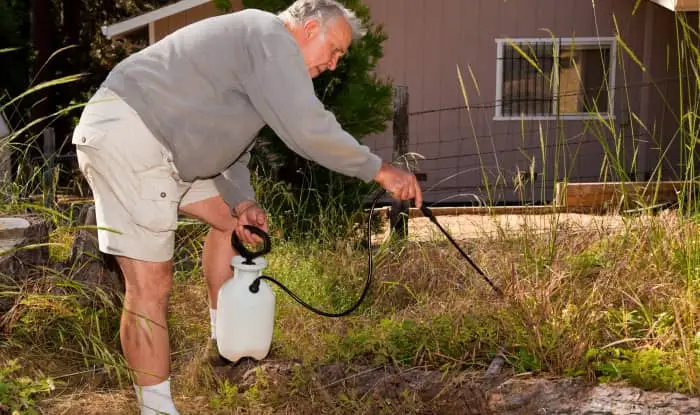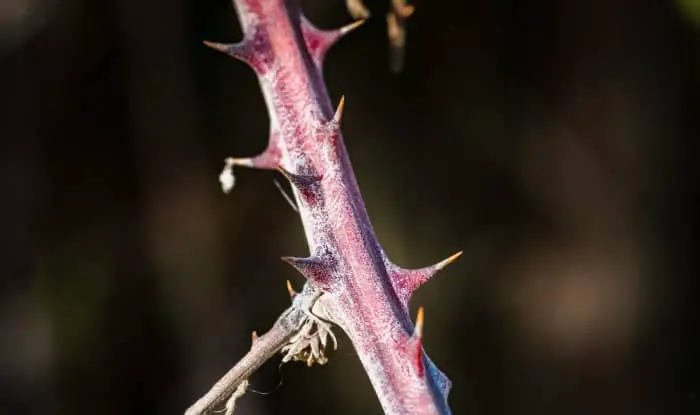Prickly weeds are among the worst weeds to find in your garden. They’re painful to stand on and brush against. And their sharp spines make weed removal difficult.
But it’s important not to let them grow. Because the only thing worse than a prickly weed is a yard full of them.
Despite the difficulties, you can get rid of prickly weeds by hand. To make it easier to lift them out you can use a weeding tool. And if the weeds are well-established and the infested area large, then you can try herbicides, weed flaming, or solarization.
But you have to employ these methods in the right way to get good results.
So in this article, we’ll take a look at how to get rid of prickly weeds growing in your yard.
Let’s dive in!
Getting Rid Of Prickly Weeds By Hand
There are obvious difficulties with pulling prickly weeds by hand. You have to be careful how you grab them to avoid sharp spines or thorns. But it’s one of the most effective methods to remove weeds and prevent them from growing back.
Before you start, get a good pair of gardening gloves for thorns. This protects your hands if you accidentally grab hold of anything sharp. Which is almost inevitable when dealing with prickly weeds like thistles.
Next, grab the weed around the base, bunching up the leaves if necessary to get at the central stalk. Try to avoid the prickles on the leaves and stem as much as possible. Don’t grab the weed halfway up the stem. It’s likely to break off leaving the roots in the ground.
Once you’ve got hold of the weed, pull and twist to bring the roots out of the ground. It’s a good idea to water the soil around the weed first to make it softer.
Getting rid of weeds by hand is easiest when the plant is young. As the weeds grow taller and the root system extends deeper it gets more difficult. And hand pulling doesn’t work well for all weeds. So it’s a good idea to identify the prickly weed before you start.
Some weeds can regrow from roots or rhizomes that are left in the soil. And the roots easily break. So make sure you don’t leave any pieces behind.
Using a weeding tool is a good option for removing prickly weeds that are too difficult to get rid of by hand.
Weeding Tools
Weeding tools make an easier job of digging or cutting spiny weeds.
To remove deep-rooted weeds, you can use a gardening shovel to dig around and under the weed and lift it out of the soil. You can also remove the weed using a kneeling tool such as a garden trowel or claw rake if the roots are shallow.
And if you don’t fancy digging, then a long-handled hoe is an effective way to cut down many weeds at a time. The best type of hoe to use is a scuffle hoe. It has a sharp blade that severs the roots just beneath the surface of the soil. Some weeds will regrow. But if you cut them down every time they send up a new shoot you can exhaust and kill the plant.
Make sure you don’t leave any weed stems or roots lying on the ground after you finish. Many weeds can re-root and start growing again.
Herbicides
For getting rid of weeds from large areas, or prickly weeds that are difficult to remove manually, it’s hard to beat the simplicity of using herbicides.
Systemic chemical herbicides kill the weeds down to their roots. Preventing regrowth. They come in 2 different types: selective and non-selective herbicides.
Non-selective herbicides kill any plant you spray them on. So you have to be careful when using them in your garden. Selective herbicides are usually formulated for killing broadleaf weeds and certain types of grassy weeds. This makes them a better choice for spraying on your lawn as they won’t damage your grass.
But what if you don’t want to use chemical weed killers in your yard? You can try a natural weed killer like vinegar instead.
Will Vinegar Kill Prickly Weeds?
When used in the right way, vinegar kills most prickly weeds. Vinegar is a contact herbicide that quickly kills the parts of the weed that you spray it on. To kill the prickly weed above ground, make sure the plant is well soaked. It’s also a good idea to soak the soil with vinegar around the weed. Why?
Because if you don’t kill the roots the prickly weed will often grow back. You might have to apply vinegar to the root zone a few times. But eventually, it should kill the weed and prevent it from regrowing.
Some people claim good results using table vinegar. But it’s less likely to damage the weed, particularly if the plant is mature. Instead, try using vinegar with a higher concentration of about 20% acetic acid.
Because vinegar is non-selective, it will harm your grass and any other plants it touches. So be careful when using it.
Make sure to wear protective gear when using high-strength vinegar. It doesn’t just burn weeds, it can also burn your skin.
Weed Burner
An easy way to kill prickly weeds is by using a flame torch. It has a number of advantages:
You don’t have to grab hold of spiky stems and leaves. And you don’t have to bend your back to dig the weed out of the ground. Instead, you can eliminate the weeds by walking around your yard briefly flaming them as you go.
Flame weeding kills the weed above ground. But it doesn’t kill the roots. So you may have to repeat the process if the weed grows back. But if you keep doing it the weeds will die.
Black Plastic Sheeting
Another way of killing spiky weeds that doesn’t involve you having to touch them is to cover them with black plastic sheeting.
The sheeting prevents sunlight from reaching the weeds, stopping them from photosynthesizing. And if you apply it to the ground for 2-3 months during the hottest time of the year it heats the ground in a process known as solarization. Killing the weeds that are growing as well as the seeds in the soil.
After you’ve applied the sheeting, remember to weigh it down at the edges to stop it from blowing away.
Black plastic sheeting works better for weeds that grow low to the ground such as spurweed. But tall-growing spiky weeds might still puncture through the sheeting as they grow, even if you apply it when they are young.
FAQ
How Do You Get Rid Of Grass Thorns?
If you’re finding grass thorns then your lawn has probably been invaded by one of several types of burr weeds, such as burr medic or spurweed. These weeds are not very competitive. So keeping your lawn thick and healthy usually prevents them becoming established. And their roots systems are shallow. So you can easily dig the plants out.
To get rid of the spiky balls these weeds leave in your grass, try regular mowing at a low setting. Make sure you have a bag attached to collect the debris, which will include the prickly burrs.
When Should I Treat My Yard For Stickers?
Stickers are usually a sign that you have spurweed — also called lawn burweed and sticker weed — in your lawn. Lawn burweed is a cool-season annual weed. To prevent it from growing you should use a pre-emergent herbicide in the fall.
Then continue to watch for any plants that grow during the winter and remove them or kill them with a post-emergent herbicide. This will prevent the weed from spreading the stickers around your yard in the Spring.
Regular mowing at a low height throughout spring and summer can help to clear up the stickers.
How Do You Get Rid Of Thorn Vines?
Thorny vines, such as Smilax, can be persistent. Prune the vines down to the ground. And keep doing this every time they regrow. It takes a long time, but you can wear the plant out by preventing it from photosynthesizing. This works best if the vine is small.
Alternatively, you can try using a brush killer to kill the root system. During the growing season, cut the vines back. Then place the cut ends in a container of herbicide and leave them to soak. Keep repeating until the vine weed dies.
What Is The Best Way To Get Rid Of Thorn Bushes?
Cut the thorn bushes close to the ground. Then apply a systemic weed killer or brush killer to the cut stems to kill the roots of the plant. When the plant is dead and no longer capable of regrowth, dig the roots out of the ground. Carefully dispose of all parts of the thorn bush.
Featured image: Thistle by John Tann



